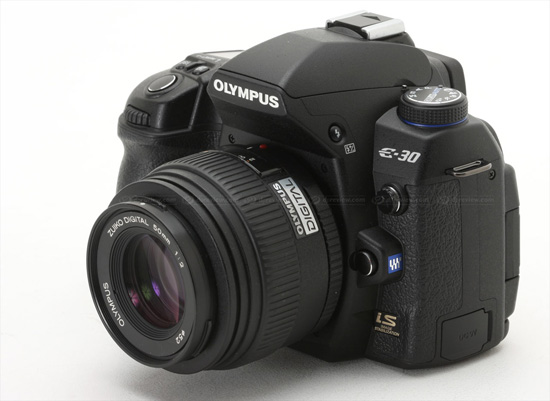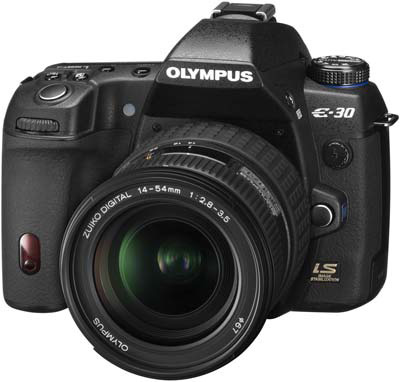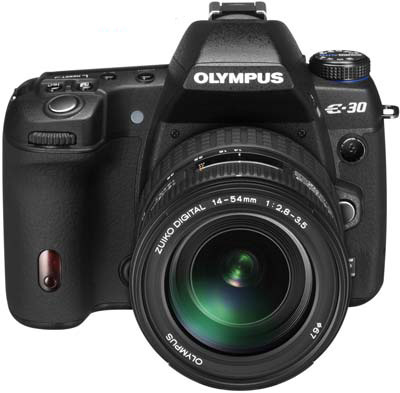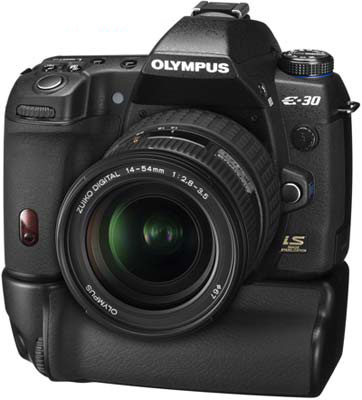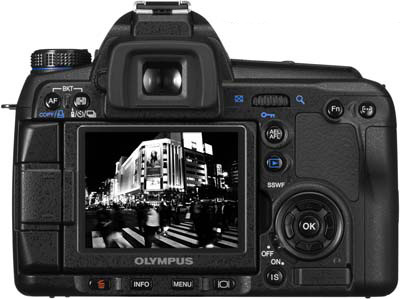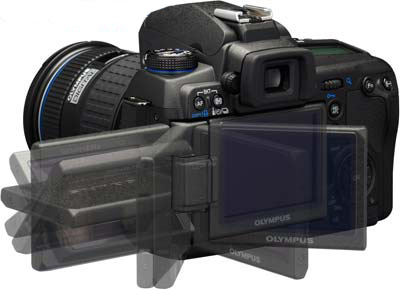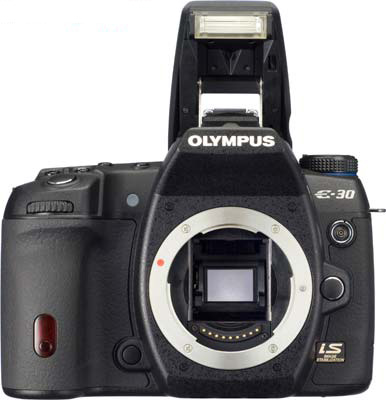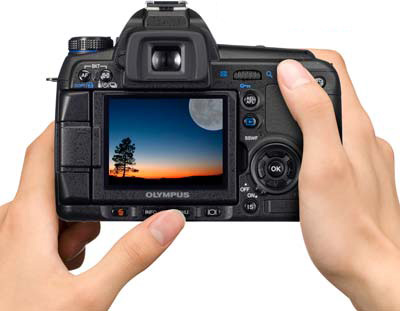 The Olympus E-30 is a new 12.3 megapixel Four Thirds Standard DSLR camera. Positioned between the pro E-3 and consumer E-520 models, the mid-range Olympus E30 offers Live View framing via the free-angle 2.7” LCD screen, 11-point autofocus, 5fps sequential shooting, shutter speeds of up to 1/8000th sec, Supersonic Wave Filter dust reduction system and built-in image stabilisation.
The Olympus E-30 is a new 12.3 megapixel Four Thirds Standard DSLR camera. Positioned between the pro E-3 and consumer E-520 models, the mid-range Olympus E30 offers Live View framing via the free-angle 2.7” LCD screen, 11-point autofocus, 5fps sequential shooting, shutter speeds of up to 1/8000th sec, Supersonic Wave Filter dust reduction system and built-in image stabilisation.
The E30 offers six Art Filters (Pop Art, Soft Focus, Pale & Light Colour, Light Tone, Grainy Film and Pin Hole), and there’s also a Multiple Exposure mode and nine separate aspect ratios. An integrated Level Gauge appears on the LCD, in the viewfinder, and on the Control Panel on the back of the camera, so your horizons should always be straight. The Olympus E-30 will be available from mid-January 2009 and retail for $1300 body only.
A creative photographer’s most important tool is the power of expression – and the Olympus E-30 delivers it in spades. For the ultimate in artistic expression, the E-30 offers six Art Filters*, each of which uses different settings to create incredible photographic effects that would otherwise require additional lenses, filters or complex editing. A Multiple Exposure* mode further bolsters the potential for distinctive artistry in compositions, as do the choice of nine separate aspect ratios*. With the newly-developed high-speed 12.3 Megapixel Live MOS sensor* and TruePic III+ image processor*, top quality image results are ensured. Ensuring an enjoyable photo experience, the monitor facilitates Live View framing ease from virtually any angle. Furthermore, thanks to built-in image stabilisation*, shots stay impressively sharp irrespective of the attached lens. And because sometimes the perfect shot can present itself in the blink of an eye, the E-30 boasts a range of high-speed performance features to make sure that you’ll always be ready for it: lightning-fast autofocus speeds, 5fps sequential shooting and shutter speeds of up to 1/8000th sec. The E-30 will be available from mid-January 2009 and retail for £xxx.
Express yourself
Six innovative Art Filters enables special artistic effects to be created directly in the camera and put you in control of your composition: styles like Pop Art*, Soft Focus*, Pale & Light Colour*, Light Tone*, Grainy Film* and Pin Hole* let you capture your world the way you want to portray it. These effects would normally require special lenses, filters, or image processing programs, but with the E-30, it all happens inside the camera. You can even preview the effect of a particular filter on the 2.7”/6.9cm HyperCrystal* II LCD before shooting. What’s more, in Multiple Exposure* mode, several images can be superimposed on a previously-captured image to take photographic creativity to a whole new level. The E-30 also offers nine different aspect ratios* for nine different takes on any scene. In addition, Live View* with improved high-speed contrast autofocus** depictions allows for easy framing of shots on the free-angle LCD.
Quality results
A range of great technologies helps ensure that the E-30 provides picture-perfect images every time. The newly developed 12.3 Megapixel Live MOS sensor provides amazing image quality at low power requirements. Combine this with the new TruePic III+ ultra high-speed image processor, and results must be seen to be believed. Built-in mechanical image stabilisation rounds up the package, significantly reducing image blur caused by such factors as low light or camera shake. And to ensure that the E-30’s powerful sensor remains dust-free, the patented Olympus Supersonic Wave Filter* is integrated.
A need for speed
Ever waited and waited for that perfect shot, and then missed it because your camera couldn’t keep up with the action? You don’t have to worry anymore because the E-30 is always prepared. High-speed shooting of up to 5fps in full 12.3 Megapixel mode and shutter speeds of up to 1/8000th sec. will help you capture even the fastest action shots. In addition, the E-30 incorporates a fully-biaxial 11-point AF system for incredible autofocusing speeds in any lighting conditions.
Additional features and accessories
For photographers looking for integrated features to improve their shooting experience, the E-30 has a lot to offer. Shadow Adjustment Technology* helps lighten shadows in shots, while Face Detection Technology* recognises and focuses on the faces of subjects in a composition. An integrated Level Gauge* also appears on the LCD, in the viewfinder, and on the Control Panel on the back of the camera. This functions like a level used in construction to ensure that your pictures will never be askew. And when it comes to accessories, the E-30 also covers the whole range. As part of the Olympus E-System and based on the Four Thirds Standard, many lenses and other accessories are available to ensure the E-30 takes creativity to a higher level. From fish-eye, macro and ultra-wide-angle lenses through to ultra-zoom models, the ZUIKO DIGITAL range of lenses leaves nothing to be desired. New in the line-up is the ZUIKO DIGITAL 14-54mm 1:2.8-3.5 II lens, which also enables full contrast AF performance with the E-30.
The Olympus E-30 gives photographers a portable creative studio and provides everything required to live out and express creativity while enjoying pro-level image results, control and performance. It will go on sale from mid-January 2009.
* Please see Appendix at the end of the document
** Full contrast AF performance is available with new Olympus lenses including the ZUIKO DIGITAL ED 9-18mm 1:4.0-5.6, the ZUIKO DIGITAL ED 14-42mm 1:3.5-5.6, the ZUIKO DIGITAL ED 40-150mm 1:4.0-5.6, the ZUIKO DIGITAL 25mm 1:2.8 “pancake” lens and the new ZUIKO DIGITAL 14-54mm 1:2.8-3.5 II.
The Olympus E-30 digital SLR – main features:
Creativity
• Art Filters, Multiple Exposure, Wireless Flash*, Multi-Aspect
• Comfortable Live View thanks to high-speed contrast AF
• Free-angle 2.7”/6.9cm HyperCrystal II LCD
Image Quality
• Newly developed 12.3 Megapixel Live MOS Sensor
• TruePic III+ processor for ideal colour reproduction and low noise
• Built-in IS with max. 5 EV steps efficiency
Speed
• High-speed 11-point fully-biaxial AF performance
• Max. 5fps
• 1/8000th sec. high speed shutter & 1/250th sec. flash synchronisation
Additional features of the Olympus E-30:
• Multiple-exposure function with LCD monitor display of current view superimposed on top of previously captured image
• Auto gradation adjustment to prevent blown highlights and blocked-in shadows
• Face & Background Control for beautifully balanced exposures of foreground subjects and background scenery
• Perfect Shot Preview to enable comparison of the results of various settings adjustments before actual shooting
• Reliable Supersonic Wave Filter dust reduction system
• Built-in flash with commander function for wireless off-camera flash synchronisation
• Large optical viewfinder with approx 98% field of view and approx 1.02x magnification
• Shooting information displayed via top-mounted LCD panel and Super Control Panel LCD monitor display for superior visibility and operating ease
• High-precision, 49-zone metering system
• Easy activation of shooting functions via sample image selection
• Versatile bracketing functions for ISO, white balance, exposure, and flash
• Lightbox view with enlargement function for easy side-by-side comparison of images
• Based on the Four Thirds Standard
• Ergonomic design of body, control buttons and GUI for easy operation
• AE/AF lock functionality for individual customisation
• Second display for Super Control Panel
• ISO 100-3200 for wide-ranging sensitivity
• Built-in flash (GN13) and wireless flash control directly from the camera body
• Wireless flash control in up to 3 groups (separate press release available for Olympus FL-50R and FL-36R flash units)
• Hi-Speed USB 2.0 interface
• High-speed data writing and lossless RAW compression for quick processing
• Simultaneous writing of RAW and JPEG
• 27 shooting modes (5 Exposure Modes, 5 Creative Modes, 11 Scene Select Modes, 6 Art Filters)
• Wide dynamic range in highly lit areas
• Dual memory slot for CompactFlash and xD-Picture Cards (incl. support for UDMA High-Speed CF cards and Microdrive)
The Olympus E-30 is available in the following configurations:
• Olympus E-30 body only
• E-30 body with ZUIKO DIGITAL ED 12-60mm 1:2.8-4.0 lens
• E-30 body with ZUIKO DIGITAL 14-54mm 1:2.8-3.5 II lens
• E-30 body with ZUIKO DIGITAL ED 14-42mm 1:3.5-5.6 lens
Appendix
Art Filters
Enables special artistic effects to be created directly in the camera. The following Art Filters are available in the Olympus E-30:
Pop Art: Enhances colours, making them stronger and more vivid to create high-impact pictures that express the happy, light-hearted feeling of the pop art style.
Soft Focus: Creates a soft tone which gives pictures an ethereal, otherworldly atmosphere. It renders pictures as though they were veiled in heavenly light, without obscuring details such as the hair or flower petals.
Pale & Light Colour: The foreground is enclosed in flat, gentle light – similar to a flashback scene in a film – creating a sense of déjà vu.
Light Tone: Creates a picture with a gentle feel to it, similar to one taken under artificial lighting. Both the shade and highlight areas are rendered very softly to provide a sophisticated atmosphere.
Grainy Film: This effect recreates the feeling of reality evoked by grainy, high-contrast monochrome pictures. The strong presence and dramatic atmosphere make the subject stand out impressively.
Pin Hole: Reduces the peripheral brightness like an image seen through a pinhole. Added to this is a unique colour tone that results in a style that has an air of secrecy or portrays the feeling of being lost in another dimension or space.
Built-in image stabiliser
A type of image stabiliser that is built directly into the camera. This enables the photo-enhancing effects of image stabilisation to be enjoyed irrespective of the attached lens. In Olympus E-System cameras with built-in image stabilisation, a gyro sensor detects the precise direction of the shake. Using the on-board SWD, the shake is then compensated for by shifting the image sensor according to the movement data. For quick response at long focal lengths, cameras are equipped with two dedicated microprocessors: one to control the two supersonic motors that shift the unit vertically and horizontally, and one to provide high-precision control.
Face Detection Technology
A technology that searches for faces in a composition and recognises them as the main subject. It then automatically puts them in focus and optimally adjusts exposure to create an image that’s sharp in the right places and ideally exposed.
High Speed Live MOS Sensor
A high-performance image sensor that enables Live View capabilities and fast sequential shooting for D-SLR cameras. It combines the advanced specifications of a Full Frame Transfer (FFT) CCD with the low power requirement of a CMOS. Photodiodes are deeply embedded in the sensor to suppress image noise. The faithful reproduction of subject details with rich tones and natural, vibrant colours characterise this type of sensor.
HyperCrystal
A high-grade, fully-transmissive technology used in LCDs, which employs an additional layer at the bottom of the LCD to reflect light from external light sources. This enhances the brightness of the LCD, so even in direct sunlight images are displayed sharply and with improved contrast compared to that of conventional displays. Also, it provides for particularly wide viewing angles without glare or shadow, so images can be framed from a variety of angles and viewed by several people at once.
Level Gauge
The Level Gauge functions like a level used in construction – it helps ensure that pictures are straight and even. The built-in dual axis sensor detects the levels in roll and pitch. The level gauge is displayed in the viewfinder, on the Control Panel and on the rear LCD.
Live View
Provides an alternative to framing shots through the viewfinder on a digital SLR camera. The image sent through the lens to the image sensor is displayed directly on the camera’s LCD. Whereas most compact digital cameras have been equipped with Live View functionality for many years, this feature has only recently become available on D-SLRs. The world’s first D-SLR to feature continuous Live View capabilities was the Olympus E-330.
Multi Aspect
The E-30 lets photographers choose from nine different aspect ratios that enable individualised framing of scenes. These provide a new means of adding expression to shots and the selected ratio can be seen directly on the camera’s LCD. The available aspect ratios include: 16:9, 3:2, 7:5, 4:3, 5:4, 6:5, 7:6, 7:5 and 6:6.
Multi Exposure
Multiple exposures are possible with the E-30 in both Live View and viewfinder shooting. In Live View shooting, previously shot RAW data is used as the base image and the final photo can be monitored by overlapping the image to be added on the LCD. Up to four images can be superimposed in a single multiple exposure sequence.
RC Wireless Flash Control
The user can control wireless flash units remotely – eliminating the need for extra cables – by using the built-in flash as the system’s master unit. Control options include the ability to independently regulate flash mode and compensation settings for up to three groups of flashes, four channel settings to avoid interference as well as a wide range of brightness levels.
Shadow Adjustment Technology
A technology designed to improve exposure for pictures with dark areas. Using a sensor that works much like the human eye, dark parts of a composition (e.g. a shadow under a tree) are identified and the camera then adjusts the exposure settings accordingly for those areas. The result is a more realistic and detailed picture.
Supersonic Wave Filter
Dust entering digital SLRs, for example during lens changes, can cause damage to photos – unless it is removed. With the Supersonic Wave Filter, the potential for dust to ruin photos is eliminated. A transparent filter is located between the camera’s shutter and sensor. It makes sure no dust is able to land on the sensor. Instead, the particles settle on the filter and are then shaken off by a series of ultrasonic vibrations generated by the filter when activated. Olympus was the first manufacturer to incorporate dust protection in D-SLRs.
TruePic III+ image processor
Olympus’ latest-generation image processing engine. It automatically enhances important aspects of image quality including: colour reproduction (colour range, saturation and brightness), picture sharpness (reduced image noise, improved edge reproduction), as well as providing faster processing speeds. Furthermore, it supports Art Filters to enable unprecedented creative expression.
